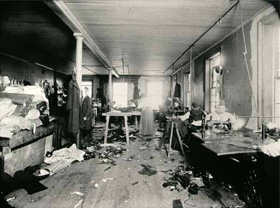The Triangle Waist Company was in many ways a typical sweated factory in the heart of Manhattan, at 23-29 Washington Place, at the northern corner of Washington Square East. Low wages, excessively long hours, and unsanitary and dangerous working conditions were the hallmarks of sweatshops.
Even though many workers toiled under one roof in the Asch building, owned by Max Blanck and Isaac Harris, the owners subcontracted much work to individuals who hired the hands and pocketed a portion of the profits. Subcontractors could pay the workers whatever rates they wanted, often extremely low. The owners supposedly never knew the rates paid to the workers, nor did they know exactly how many workers were employed at their factory at any given point. Such a system led to exploitation.
Even today, sweatshops have not disappeared in the United States. They keep attracting workers in desperate need of employment and undocumented immigrants, who may be anxious to avoid involvement with governmental agencies. Recent studies conducted by the U.S. Department of Labor found that 67% of Los Angeles garment factories and 63% of New York garment factories violate minimum wage and overtime laws. Ninety-eight percent of Los Angeles garment factories have workplace health and safety problems serious enough to lead to severe injuries or death.
The International Ladies' Garment Workers Union organized workers in the women's clothing trade. Many of the garment workers before 1911 were unorganized, partly because they were young immigrant women intimidated by the alien surroundings. Others were more daring, though. All were ripe for action against the poor working conditions. In 1909, an incident at the Triangle Factory sparked a spontaneous walkout of its 400 employees. The Women's Trade Union League, a progressive association of middle class white women, helped the young women workers picket and fence off thugs and police provocation. At a historic meeting at Cooper Union, thousands of garment workers from all over the city followed young Clara Lemlich's call for a general strike.
With the cloakmakers' strike of 1910, a historic agreement was reached, that established a grievance system in the garment industry. Unfortunately for the workers, though, many shops were still in the hands of unscrupulous owners, who disregarded basic workers' rights and imposed unsafe working conditions on their employees.

